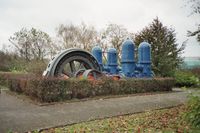Pump
2008/9 Schools Wikipedia Selection. Related subjects: Engineering

A pump is a device used to move gases, liquids or slurries. A pump moves liquids or gases from lower pressure to higher pressure, and overcomes this difference in pressure by adding energy to the system (such as a water system). A gas pump is generally called a compressor, except in very low pressure-rise applications, such as in heating, ventilating, and air-conditioning, where the operative equipment consists of fans or blowers.
Pumps work by using mechanical forces to push the material, either by physically lifting, or by the force of compression.
The earliest type of pump was the Archimedes screw, first used by Sennacherib, King of Assyria, for the water systems at the Hanging Gardens of Babylon and Nineveh in the 7th century BC, and later described in more detail by Archimedes in the 3rd century BC. In the 13th century AD, al-Jazari described and illustrated different types of pumps, including a reciprocating pump, double-action pump, suction pump, and piston pump.
Types
Pumps fall into two major groups: rotodynamic pumps and positive displacement pumps. Their names describe the method for moving a fluid.
Positive displacement pumps

A positive displacement pump causes a fluid to move by trapping a fixed amount of it then forcing (displacing) that trapped volume into the discharge pipe. The periodic fluid displacement results in a direct increase in pressure. A positive displacement pump can be further classified as either
- a rotary-type (for example the rotary vane),
- lobe pump similar to oil pumps used in car engines, or
- the Wendelkolben pump or the helical twisted Roots pump.
Roots-type pumps
The low pulsation rate and gentle performance of this Roots-type positive displacement pump is achieved due to a combination of its two 90° helical twisted rotors, and a triangular shaped sealing line configuration, both at the point of suction and at the point of discharge. This design produces a continuous and non-vorticuless flow with equal volume. High capacity industrial "air compressors" have been designed to employ this principle as well as most "superchargers" used on internal combustion engines.
Reciprocating-type pumps
Reciprocating-type pumps use a piston and cylinder arrangement with suction and discharge valves integrated into the pump. Pumps in this category range from having "simplex" one cylinder, to in some cases "quad" four cylinders or more. Most reciprocating-type pumps are "duplex" (two) or "triplex" (three) cylinder. Furthermore, they are either "single acting" independent suction and discharge strokes or "double acting" suction and discharge in both directions. The pumps can be powered by air, steam or through a belt drive from an engine or motor. This type of pump was used extensively in the early days of steam propulsion (19th century) as boiler feed water pumps. Though still used today, reciprocating pumps are typically used for pumping highly viscous fluids including concrete and heavy oils.
Compressed-air-powered double-diaphragm pumps
Another modern application of positive displacement pumps are compressed-air-powered double- diaphragm pumps. Run on compressed air these pumps are intrinsically safe by design, although all manufacturers offer ATEX certified models to comply with industry regulation. Commonly seen in all areas of industry from shipping to process, SandPiper, Wilden Pumps or ARO are generally the larger of the brands. They are relatively inexpensive and can be used for almost any duty from pumping water out of bunds, to pumping hydrochloric acid from secure storage (dependant on how the pump is manufactured - elastomers / body construction). Suction is normally limited to roughly 6m although heads can be almost unlimited.
Kinetic Pumps
- Continuous energy addition
- Conversion of added energy to increase in kinetic energy (increase in velocity)
- Conversion of increased velocity to increase in pressure
- Conversion of Kinetic head to Pressure Head.
- Meet all heads like Kinetic , Potential, and Pressure
Application
Pumps are used throughout society for a variety of purposes. Early applications includes the use of the windmill or watermill to pump water. Today, the pump is used for irrigation, water supply, gasoline supply, air conditioning systems, refrigeration (usually called a compressor), chemical movement, sewage movement, flood control, marine services, etc.
Because of the wide variety of applications, pumps have a plethora of shapes and sizes: from very large to very small, from handling gas to handling liquid, from high pressure to low pressure, and from high volume to low volume.
Liquid and slurry pumps can lose prime and this will require you to prime the pump by adding liquid to the pump and inlet pipes to get the pump started.
Specifications
Pumps are commonly rated by horsepower, flow rate, outlet pressure in feet of head, inlet suction in suction head in feet. Feet is the number of feet the pump can raise or lower a column of water at atmospheric pressure.
Pumps as public water supplies
One sort of pump once common worldwide was a hand-powered water pump over a water well where people could work it to extract water, before most houses had individual water supplies.
From this came the expression "parish pump" for "the sort of matter chattered about by people when they meet when they go to get water", "matter of only local interest".
Today, hand operated village pumps are considered the most sustainable low cost option for safe water supply in resource poor settings, often in rural areas in developing countries. A hand pump opens access to deeper groundwater that is often not polluted and also improves the safety of a well by protecting the water source from contaminated buckets. Pumps like the Afridev pump are designed to be cheap to build and install, and easy to maintain with simple parts. It was assumed that spare parts would become available in the local market by for-profit wholesalers. However, it became clear with time that often spare parts are not available locally, because of the low profit margins for wholesalers, especially in Africa. This means that communities are often stuck without spares and cannot use their handpump anymore and have to go back to traditional and sometimes distant, polluted resources. This is unfortunate, as water projects often have put in a lot of resources to provide that community with a handpump. As a result, spare parts free handpumps are now being developed, like the Afripump.



